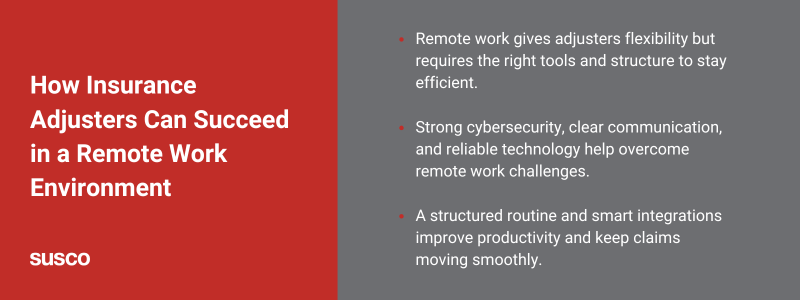
Insurance adjusting has never been a typical desk job. Fieldwork, client meetings, and on-the-go assessments have always been part of the process. But in recent years, remote work has transformed how adjusters operate.
No longer tied to an office, adjusters can now handle claims, collaborate with teams, and manage reports from anywhere with an internet connection.
This shift brings plenty of benefits—greater flexibility, lower costs, and faster claims processing—but it also introduces new challenges. Adjusters must stay productive without the structure of an office, protect sensitive data from cyber threats, and maintain clear communication with colleagues and clients.
The key to making remote work effective lies in the right tools, habits, and strategies. So, how can adjusters thrive in a remote environment? This blog breaks down the benefits, challenges, and best practices to help adjusters stay connected, efficient, and secure while working from anywhere.
The benefits of remote work for insurance adjusters
Gone are the days when insurance adjusters had to be tethered to an office or spend hours commuting. Remote work has opened new doors, making it easier to process claims, connect with clients, and manage workloads without geographical limitations.
This shift isn’t just about convenience—it’s transforming efficiency and profitability for adjusters and the firms they work for.
Here’s how remote work is reshaping the industry for the better:
- Increased flexibility: Adjusters can manage their schedules more effectively, reducing stress and improving response times.
- Expanded service areas: Without being tied to a physical office, adjusters can handle claims across wider regions.
- Reduced costs: Less commuting means lower travel expenses, and firms can save on office overhead.
- Faster claims processing: Digital tools and remote access speed up documentation and approvals.
Remote work isn’t just an option for insurance firms and adjusters willing to embrace these advantages—it’s a competitive edge.
Challenges of remote work for adjusters
Remote work offers freedom, but it also comes with obstacles. Adjusters must stay productive, protect sensitive data, and keep communication seamless—all without the structure of a traditional office.
Without the right systems in place, these challenges can slow down claims processing and create unnecessary risks.
Here’s what adjusters and firms need to watch out for:
- Technology issues: A slow internet connection or outdated software can disrupt workflows and delay claims.
- Data security risks: Adjusters handle sensitive information, making strong cybersecurity measures a must.
- Communication gaps: Without in-person meetings, teams need structured check-ins to stay aligned.
- Blurry work-life boundaries: The lack of separation between home and work can lead to burnout.
Recognizing these challenges is the first step. With the right tools and strategies, adjusters can overcome these hurdles and maximize the benefits of remote work.
Essential tools for remote insurance adjusters
The right tools make remote work seamless. Adjusters need fast, secure, and reliable insurance adjusting technology to process claims, communicate with teams, and access critical data from anywhere. Without the right setup, delays, errors, and security risks become bigger problems.
Here’s what every remote adjuster needs:
- Claims management software: Platforms like XactAnalysis, Guidewire, and custom-built solutions streamline claims processing.
- Mobile workforce apps: Adjusters can document claims, upload photos, and access policy details on the go.
- Secure cloud storage: Real-time access to claims data keeps information organized and protected.
- Video conferencing tools: Zoom and Microsoft Teams make virtual meetings easy and efficient.
- Collaboration platforms: Slack and Microsoft Teams keep communication smooth and organized.
With the right tools in place, remote adjusters can work smarter, stay connected, and process claims faster—no matter where they are.
Mental health and remote work in the insurance industry
Remote work offers flexibility, but it also comes with mental health challenges—especially for insurance adjusters. The job itself is demanding, with high caseloads, strict deadlines, and the emotional weight of handling claims after disasters or accidents.
Without the structure and social interaction of an office, stress, isolation, and burnout become real concerns.
Here’s how adjusters can protect their mental well-being while working remotely:
- Set clear work boundaries: Establish start and end times to prevent work from spilling into personal time.
- Take regular breaks: Short breaks throughout the day improve focus and reduce stress.
- Stay socially connected: Check in with colleagues, even if it’s just a quick chat, to avoid feeling isolated.
- Use mental health resources: Many insurance firms offer wellness programs or counseling services. Take advantage of them.
- Manage workload effectively: Prioritize tasks, delegate when possible, and avoid overloading your schedule.
Remote work shouldn’t mean working alone. Adjusters can protect their mental health and stay effective in their roles by maintaining balance and staying connected.
Tips for staying productive and connected
Working remotely gives adjusters flexibility, but staying focused and connected takes effort. Without a structured office environment, it’s easy to fall into distractions, miscommunications, or security risks.
A few simple strategies help adjusters stay on track and work efficiently.
Here’s how to make remote work more productive:
- Set a structured schedule: A consistent routine keeps tasks organized and deadlines on track.
- Create a dedicated workspace: A quiet, clutter-free area improves focus and efficiency.
- Use automation and integrations: Automating tasks speeds up claims processing and reduces errors.
- Check-in regularly: Virtual meetings keep teams aligned and prevent miscommunication.
- Prioritize cybersecurity: VPNs, multi-factor authentication, and encrypted tools protect sensitive data.
With the right habits and technology, remote adjusters can stay productive, connected, and secure while handling claims from anywhere.
How Susco supports remote work for insurance adjusters
Susco Solutions builds custom software solutions designed to support insurance adjusters in remote and hybrid work environments.
We help insurance services firms streamline their operations while ensuring security and efficiency.
Want to optimize your remote work systems?
Schedule a free one-hour assessment with Susco Solutions.